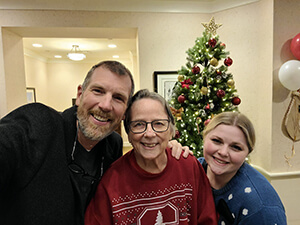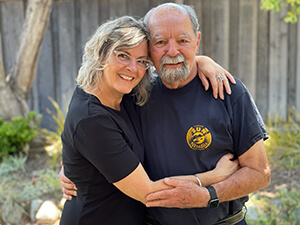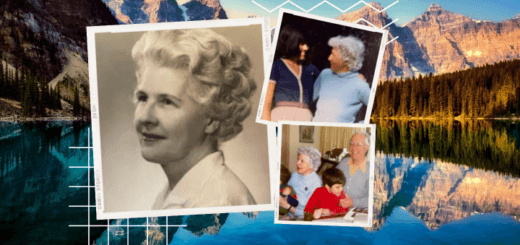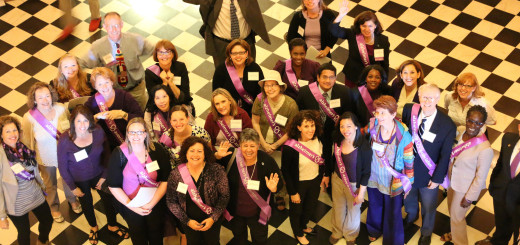Becoming an advocate: One man’s story of caring for three loved ones
Nate Donavan is currently on his third Alzheimer’s journey. First his father, then a family friend and now his father-in-law. Recently, while attending Walk to End Alzheimer’s in Silicon Valley, Nate was introduced to the advocacy efforts conducted by the Alzheimer’s Association. Having a history of lobbying for what he believes in, Nate was inspired to sign up as an advocate. He shares his story of being a third-time caregiver and the importance of educating oneself about the disease.
Caring for a family friend
Fifteen years ago, Nate’s father was diagnosed with Alzheimer’s disease. An avid runner, Nate’s father was still running marathons into his 70s. When he received his diagnosis, he willingly handed over the keys to his car and gave up running. “He said, ‘I do not want to hurt another human,’” recalled Nate. “’I’ll go for a walk, but I don’t want to get lost.’ Dad was great that way.”
When his father died, Nate assumed that his journey with Alzheimer’s had come to an end. Sadly, this was just the beginning for Nate. Two years later, a longtime friend of the family, Sheila, received her Alzheimer’s diagnosis. “She was a surrogate mom to me and a grandma to my kids,” said Nate. “She’s been a part of our lives forever.”
Sheila had already experienced great loss—her daughter in 1991, then her husband and only son had lost their battle with cancer within a year of each other. Devastated and without a support system, Sheila leaned heavily on Nate’s family, who had always been there for her.
Sheila’s husband had been the person who ran the house. When her son died, she found herself alone and unsure of what to do. Sheila called Nate for help. Nate, who had already been helping her around the house and making sure she was okay, reassured her, saying, “You have us, no matter what.”
Sheila told Nate that she was afraid to be alone. After checking with his family, Nate and his daughter agreed to move in with her. However, within a few months, it became clear something was wrong and Nate knew it was time to see a doctor.
Afraid to get diagnosed
While Nate’s father took his diagnosis in stride, Sheila did not. Instead, she felt humiliated. It took three trips to the doctor before she received an official Alzheimer’s diagnosis. “[The first trip to the doctor], whenever a question was asked, she’d look at me [for the answers],” said Nate. “The second time we went, I didn’t go in. It backfired. She became angry and felt she was being tricked and set up.
“A month later I begged her to take her back [to the doctor] and [told her] I’ll be there with you. I coached her [and told her], ‘We have to understand what’s going on. I love you, and I’d do anything for you.’ She could only answer a few questions and left [the third appointment] in tears.”
Oftentimes, an Alzheimer’s disease diagnosis can leave a person feeling disconnected, isolated or abandoned. Whenever facing difficult times, having a good support network may help someone feel socially connected and give them a sense of belonging and purpose. Nate wanted to be a support system for Sheila.
Difficult decisions for end-of-life care
Sheila continued to live with Nate for another three years before professional help was needed. Nate and his family decided the best thing for everyone was to move Sheila to a care setting where she has lived for the last five years.
Currently, Sheila is in hospice care and Nate is now faced with a new challenge of how to let this friend and mother figure die in peace. “[It would be one thing if] she was able to sit and enjoy watching tv or enjoy people, or playing music,” said Nate “but she can’t even enjoy that. She can’t enjoy anything. It’s time we look at this as a much harder decision: to aid in a civilized way to gracefully die.”
“We’re talking about: At what point is it humane dealing with [a person living with the disease’s] care,” said Nate. “In this case, I just took another class in [learning] how do we have the bigger conversation with the care provider. They’re in the business of keeping people alive. They don’t want to be accused of wrongdoing. I’m at a point where I want to [have] a plan in place for [her care].
“I’m one of four kids. When my dad died a decade ago, we sat down as a family to talk about it. When Mom died of pancreatic cancer 20 years ago, we did it as a group again. Now, I have the support of my wife, Cindy, and a few friends, but I am the primary and have to make these decisions all by myself.”
After discussing the issue with the hospice nurse, Nate was reminded that as Sheila’s legal guardian he was the one that could make the decision to treat or not treat any problems that arise. In light of this, Nate has decided to work with Sheila’s doctors to outline new ground rules for her care.
Third time a caregiver
Nate’s journey with Alzheimer’s is far from over. Recently, his father-in-law was diagnosed with the disease. Nate helps by sharing his personal experience as a caregiver with his wife’s family, and spending time with his in-laws multiple times a week.
“I’m starting on my third journey with my father-in-law,” said Nate. “My approach is a lot easier than it is for the rest of the family. He still interacts with sports, and he looks forward to it. I come over and we watch football together and we interact the entire time. We exercise the brain [because] we know everything [about football] so we’re expert armchair quarterbacks.
“Taking what I’ve learned in the past – let’s focus on what they can do and not what they can’t. When you’re new to dementia, I find you panic about what they can’t do. My father-in-law owned a motorcycle shop. He may not be able to tear down a bike like he used to, but he might be able to participate if someone else is doing it. There are other things he can be involved with.”
Alzheimer’s Association
Nate was first introduced to the Alzheimer’s Association when his father was initially diagnosed. He leaned on the Association again when Sheila started wandering and needed help getting a bracelet with her name and phone number on it.
Now, Nate’s wife Cindy works for a company that sponsors the Alzheimer’s Association Walk to End Alzheimer’s®. Through her company, they began attending Walk to End Alzheimer’s events in San Jose.
Held annually in more than 600 communities nationwide, Walk to End Alzheimer’s is the world’s largest fundraiser for Alzheimer’s care, support and research. This inspiring event calls on participants of all ages and abilities to join the fight against the disease.
From caregiver to advocate
For the past two years, Nate attended Walk to End Alzheimer’s in Silicon Valley. This year, he met Jessica Rothhaar, senior public policy manager for the Alzheimer’s Association in California. Nate felt called to speak out for those who couldn’t advocate for themselves.
“We met and struck up an immediate and fantastic conversation,” said Nate. “I grew up in a family of lobbyist and freedom fighters. The stories about my parents and what they were involved in are remarkable. This isn’t the first time I’ve done these sorts of things. My parents had us walking precincts when I was 8 years old during campaigns.
“I’m a retired high school teacher. I like to busy myself and I’m looking at fulfilling and meaningful causes to stay busy. I know Alzheimer’s relative well, but there’s always education and more to learn. Just when I think I know everything, there will be something new I’ll learn. [The Association] would be a nice fit, I’m pumped and excited.”
Nate is becoming a member of the Alzheimer’s Impact Movement (AIM) which advances and develops policies to overcome Alzheimer’s and all other dementia through increased investment in research, enhanced care and improved support. He’s also training to be a community educator, a public speaker who provides Alzheimer’s Association education programs to community audiences.
The road ahead
Nate’s journey with Alzheimer’s disease has been long, difficult, and at times, overwhelming. Through it all, he’s learned the value of support, education, and advocacy. Nate’s focus remains on staying informed and offering his knowledge to others.
Nate’s advice is simple: don’t do it alone. Reach out for support, educate yourself, and connect with the Alzheimer’s Association. Every step forward is a step toward better care and understanding.
For more information on how to become a member of the Alzheimer’s Impact Movement visit alzimpact.org.
To help fund the care, support and research efforts of the Alzheimer’s Association consider donating to the 2024 Walk to End Alzheimer’s in Silicon Valley or make a donation to alz.org/donate.





















